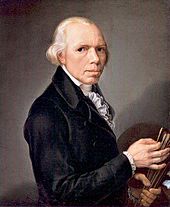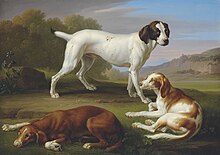Johann Wenzel Peter

Johann Wenzel Peter , Czech Jan Václav Peter , mostly Wenzel Peter , (born September 8, 1745 in Karlsbad , Bohemia , † December 28, 1829 in Rome ) was an Austrian animal painter who worked in Rome .
life and work
He was the son of the Carlsbad master gunsmith Johann Georg Peter and his wife Juliana Veronika, born in Berlin. Zißler and learned the gunsmith's trade. On his wandering he came to Brno, where he made his masterpiece, a pistol. He then went to Vienna, where he worked as a coin engraver.
Thanks to the support of Count Joseph von Kaunitz, imperial Austrian ambassador to the papal court, he came to Rome in 1774 to study sculpture. However, under the influence of Anton Raphael Mengs, he showed more interest in painting from around 1781 and specialized in animal painting.
For Prince Borghese, in 1784/85 he painted the entrance hall of the Villa Borghese casino with 162 depictions of animals and other pictures for the casino's collection. He also painted animal representations for the Palazzo Chigi and the Palazzo Altieri as well as works for the banker Alessandro Torlonia and Lord Bristol . Johann Wenzel Peter was appointed professor at the Accademia di San Luca in 1812 . Pope Gregory XVI In 1831 he bought twenty of his paintings to furnish the Sala del Concistoro in the Papal Palace , now in the Vatican Pinacoteca , including “Adam and Eve in the Garden of Eden ” depicting over two hundred animals and a lion's fight with a tiger. These paintings form the largest coherent collection of Peter's works.
His works received special mention in contemporary art criticism, for example by Johann Heinrich Meyer, who was a friend of Johann Wolfgang Goethe :
“ Peters , a Bohemian, excellent animal painter, combines in his depictions with a pure sense of nature the alluring properties of a beautiful, pithy treatment and brilliant color. Although the animals are to be regarded as the main subject of our artist, he also did not produce historical representations and portraits without praise. "
literature
- Constantin von Wurzbach : Peter, Wenzel . In: Biographisches Lexikon des Kaiserthums Oesterreich . 22nd part. Imperial-Royal Court and State Printing Office, Vienna 1870, p. 69 f. ( Digitized version ).
- Rudolf Müller : Peter, Joanes Wenceslaus . In: Allgemeine Deutsche Biographie (ADB). Volume 25, Duncker & Humblot, Leipzig 1887, p. 479 f.
- Peter, Wenceslaus . In: Hans Vollmer (Hrsg.): General lexicon of fine artists from antiquity to the present . Founded by Ulrich Thieme and Felix Becker . tape 26 : Olivier – Pieris . EA Seemann, Leipzig 1932, p. 477 .
- Peter, Johann Wenzel. In: Austrian Biographical Lexicon 1815–1950 (ÖBL). Volume 7, Verlag der Österreichischen Akademie der Wissenschaften, Vienna 1978,ISBN 3-7001-0187-2, pp. 440–35.
- Josef Weinmann: Wenzel Peter , in: Egerländer Biographical Lexicon with selected people from the former government district of Eger . Volume 2, Männedorf / ZH 1987, ISBN 3-922808-12-3 , pp. 47-48 ( digitized version ).
Web links
Individual evidence
- ^ Baptismal register Karlsbad, 1745, fol. 170: born September 8th 1745, baptized September 9th in the Maria Magdalena Church in Karlsbad: Johann Wentzl, son of Johann Georg Petter, citizen and bitch maker Mayster alhier, the mother Juliana. Sponsors: Johann Thomas Mathias, citizen and master carpenter; Johann Andreas Egrer, citizen, fabric and canvas weaver; Anna Sabina Pötzl;
- ↑ Traubuch Karlsbad, 1740, fol. 48: Wedding in Karlsbad, Church of St. Maria Magdalena on October 24th, 1740 Johann Georg Peter, citizen and master gunsmith in Karlsbad, son of the honored and well-respected Johann Georg Peter, who was resting in God, former citizen and master gunsmith of the royal family. The married son left behind in the Prussian and Churbrandenburg residence city of Berlin with the maiden of honor Juliana Veronica Zißlerin, the married daughter of the respected Alexander Zißler, citizen and master shoemaker. Groomsmen: Johann Caspar Voigt; Johann Andreas Heylinggötter; Johann Jacob Mathes;
- ↑ Internet site of the Vatican Museums, Vatican Pinacoteca, Room XVI, Adam and Eve in Paradise on Earth Entry at the museum .
- ^ Johann Heinrich Meyer, Draft of an Art History of the Eighteenth Century . In: Johann Wolfgang Goethe: Winkelmann and his century. Edited by Goethe in letters and essays. J. G. Cotta, Tübingen 1805, pp. 346-347. - Johann Wolfgang Goethe: All works according to the epochs of his work. Munich edition. Volume 6.2. Carl Hanser, Munich 1989, p. 321. - Many other Goethe editions, e.g. B. the Berlin edition (Volume 19, 2nd edition 1985), contain only the parts of Winckelmann and his century written by Goethe himself .
| personal data | |
|---|---|
| SURNAME | Peter, Johann Wenzel |
| ALTERNATIVE NAMES | Peter, Wenzel; Peter, Jan Václav (Czech) |
| BRIEF DESCRIPTION | Austrian animal painter, active in Rome |
| DATE OF BIRTH | September 8, 1745 |
| PLACE OF BIRTH | Carlsbad |
| DATE OF DEATH | December 28, 1829 |
| Place of death | Rome |


